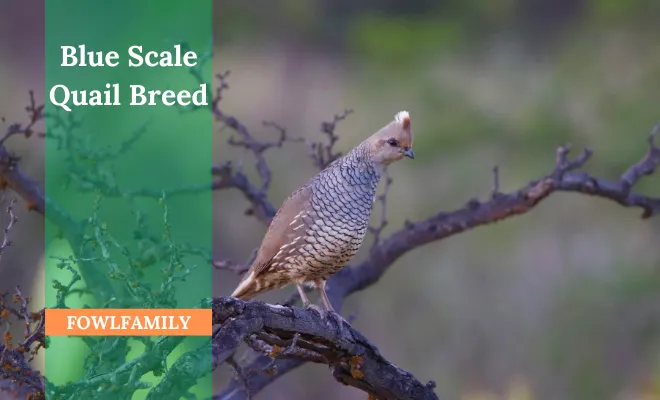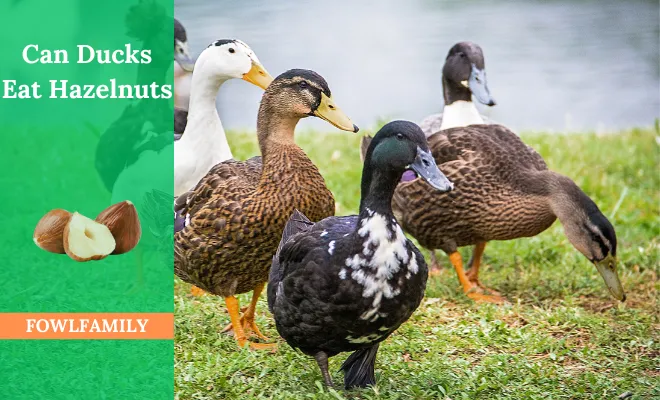12 Kind Of Duck Breeds That Can’t Fly!
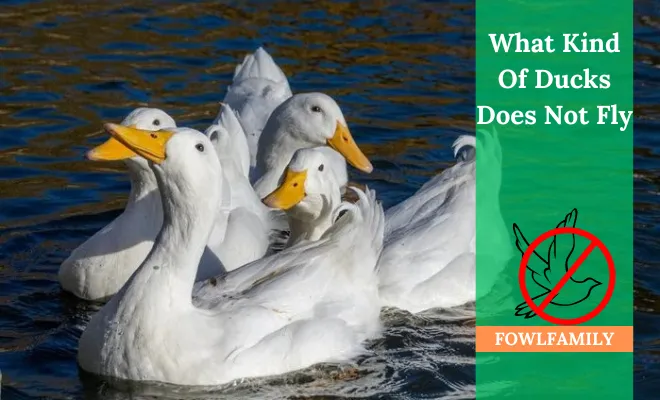
Ducks, as a bird, can fly, but some of them, primarily domestic ducks, cannot fly. It’s due to their heavy body and short wings that make it complex for flight.
But what are the duck breeds that can’t fly? Among 120+ duck breeds, I found 12 duck breeds that can’t fly and have difficulty while trying to fly. The list is included below:
- Muscovy
- American Pekin
- Indian Runner
- Khaki Campbell
- Buff Orpington
- Cayuga
- Rouen
- Ancona
- Moulard
- Welsh Harlequin
- Silver Appleyard
- Crested.
Plenty of other facts are behind their inability to fly. Dive deep to get your answer about such breeds that can’t fly.
Table of Contents
What Kind Of Ducks Does Not Fly? 12 Duck Breeds That Can’t Fly!
Being raised primarily for the production of eggs and meat, domestic ducks are primarily incapable of flying. Which causes them to gain weight in their body and make them heavier!
Certain varieties are capable of flying a few feet, so it’s not like they can’t even attempt. It isn’t regarded as a flyer, though!
Sometimes, there aren’t any land predators, so the island ducks lose their capacity to fly due to a lack of selection. For example, Falkland Steamer, Fuegian Steamer, Chubut Steamer, Auckland Teal, or Campbell Teal are flightless birds as well.
Anyway, let’s focus on the commonly kept ducks breeds that can’t fly.
1. Can Muscovy Ducks Fly?
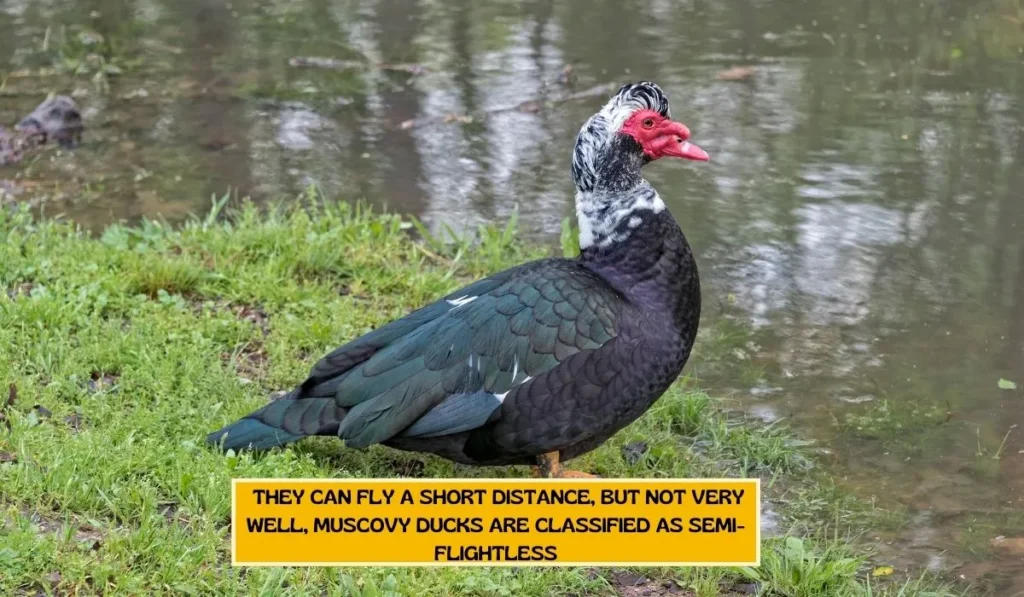
Although they can fly a short distance, but not very well, muscovy ducks are classified as semi-flightless. Despite being heavier than many other domesticated varieties, they can still fly, especially in their early years.
Nevertheless, they struggle to produce enough lift to take off because their wings are too small to support their massive bodies. They are not a good flier when grown up. Here is a video of the time when they can fly.
2. Can American Pekin Ducks Fly?

Pekin ducks are not strong fliers due to their bulky body! However, as they have wings, consider them semi-flightless like muscovy. Pekin ducks are basically kept for meat production and face challenges flying away. However, Pekin is not the only duck that won’t fly.
3. Indian Runner – Tall Ducks That Can’t Fly!

You heard the Indian Runner cannot fly, but some of them can fly up to 3 feet off the ground.
So, do they actually fly? Yes, more or less, all the ducks can lift them a little, at least. But we consider it flightless!
However, the truth is Indian Runner can manage a short flight. But they cannot be considered flying birds due to their upright posture, small wings, and structure of body.
4. Do Khaki Campbell Ducks Fly?

The Khaki Campbell duck has a poor flying ability. Because of their small weight, they are not known for long-term flight. However, they may flutter or hop briefly.
Due to the small size of their wings compared to their body, they struggle to produce enough lift to take off.
5. Why Can’t Buff Orpington Readily Fly?

Buff Orpington ducks weigh seven or eight pounds, which is too much for them to fly, even though their athletic bodies are great for producing meat. So, I added Buff Orpington to the list of duck breeds that can’t fly. Their undeveloped flight muscles and diminutive height contribute to their limited flying ability.
People often try to clip Buff duck wings, but they don’t know that such breeds can’t fly.
6. Are Cayuga Ducks Flightless For Sure?

No, they are not totally flightless as the young one or the female can fly a little. Cayuga ducks are typically observed hopping on the ground and flapping their wings. However, because they are much heavier, they are unable to fly correctly.
Their bodies are too weighty for their little wings to carry. They do struggle to produce enough lift to lift off. At maturity, Cayugas typically weigh between six and eight pounds, making them too heavy to fly.
7. Do Rouen Ducks Have The Ability To Fly?

No, Rouen ducks cannot fly seamlessly because they are a large and heavy breed of duck. Moreover, it is challenging for them to lift because of their small wings. Besides, Rouen ducks are too hefty to fly at their usual six to eight pounds.
However, the owner of the duck manages to witness a brief flight. From a flying perspective, these varieties are comparable to Pekin ducks.
Therefore, preserve them for use in other endeavors like meat production, exhibition, or household pet ownership.
8. Why Ancona Ducks Can’t Fly?

Ancona ducks, the domestic variety, do not have great flying ability, so they are on the list of duck breeds that can’t fly. Like other medium-sized duck breeds, they often have limited flight skills. Similar to other heavy-bodied breeds, they have this issue.
It’s interesting to observe how baby ducklings attempt to fly but completely fall when they weigh five or six and a half pounds. Therefore, don’t expect your flock of ancona ducks to fly; instead, keep them for their meat and eggs.
9. Why Moulard Ducks Can’t Fly? Heafty Body!
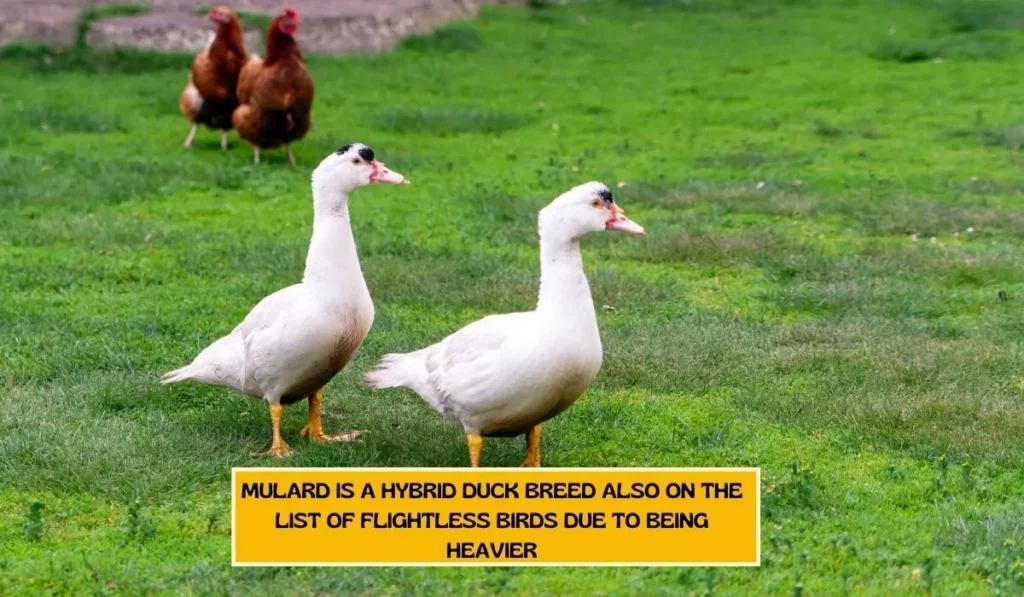
Mulard is a hybrid duck breed also on the list of flightless birds due to being heavier. They weigh 15 pounds! So, how can it be easy to fly? Quite difficult for Mule ducks!
10. What About Welsh Harlequin Ducks Flying Capability?

Welsh Harlequins are another lousy flier among all the duck breeds. The problem here is their small wings that made them a semi-flightless breed.
However, keep them for egg production as they have the highest level of egg production, around 300 to 350 eggs.
11. Can Silver Appleyard ducks fly?
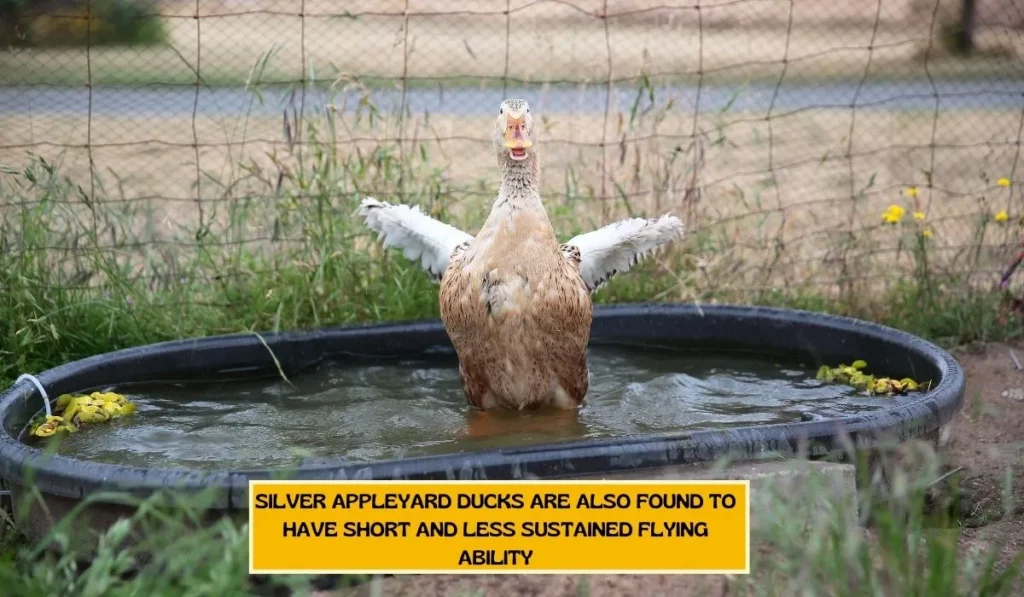
Considered an endangered breed, Silver Appleyard ducks are also found to have short and less sustained flying ability. They weigh around 8 to 10 pounds when they mature. So it becomes a little tough to fly for them. But they can fly a little distance.
12. What Causes Crested Ducks Not To Fly?

The crest on the head of a crested duck interferes with their ability to balance and maneuver in the air. That means their ability to fly is limited!
My research found that they typically suffer from neurological issues such as a shaky gait or trouble standing up.
However, keep them on your farm as they’re dual-purpose ducks and beneficial for producing both meat and eggs.
Related Articles:
9 Benefits Of Keeping Ducks That Can’t Fly
It’s not like ducks don’t fly; it is something negative. In some instances, you must have duck breeds on your farm that shouldn’t fly. However, lemme share the beneficial facts of having duck breeds that won’t fly away.
1. Family Pets
Since non-flying ducks are typically easier to handle and are less likely to wander into inappropriate locations. They can make wonderful pets, especially in family environments.
2. Less Risk of Escape
Ducks with restricted flight capabilities are less likely to flee. So, it lowers the possibility of their getting lost or wandering off.
3. Safe and Secure from Injuries
Ducks incapable of taking flight are less likely to sustain injuries from getting hurt. It can be the objects, buildings, or predators that hurt the fowl.
4. Garden and Landscape Protection
Being good foragers, you may let your non-flying ducks graze freely in your yard or garden. And you don’t have to worry about them flying over fences and possibly uprooting plants.
5. Easy to Handle
It is frequently simpler to handle and capture ducks that are not able to fly. This can be especially helpful for general maintenance, grooming, and routine health examinations.
6. Comfort Zone
Duck owners may rest easy knowing that their birds won’t go away, especially in regions where they may be in danger from predators or vehicles.
7. Friendly Pet
Ducks without wings have a lower propensity to stray into nearby properties. It reduces the possibility of running afoul of the neighbors.
8. Urban and Suburban Settings
Because they are easier to confine to smaller spaces, non-flying ducks are better. They become appropriate in urban or suburban settings with space constraints.
9. Easy Training
To teach your ducks to return to a particular area or coop, training and controlling non-flying ducks may be more manageable. They won’t fly away!
Recommended Reading: How to Potty Train Your Duck
9 Potential Disadvantages Of Keeping Duck Breeds That Don’t Fly
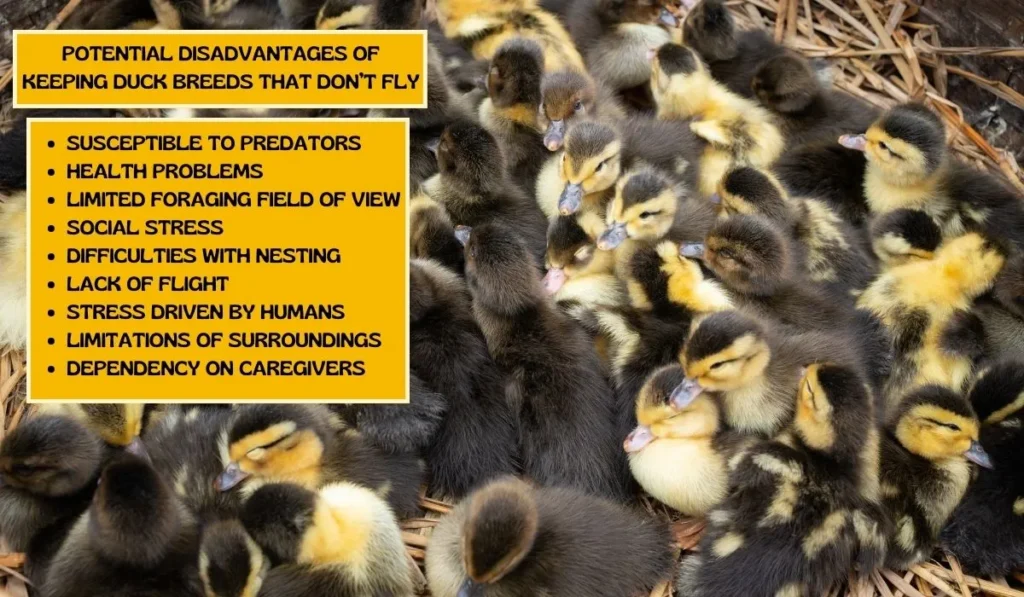
Now, let me tell you some facts about not having a duck breed that can fly when necessary.
1. Susceptible to Predators
Ducks without wings are unable to escape potential threats by air. Hawks, foxes, and other animals might attack them more frequently.
Under other circumstances, the ducks may become more agitated because of limited options for escaping dangers or harmful situations.
To ensure the safety of your ducks in a predator-populated area, you should take additional measures, such as keeping an eye on them when they’re outside and building a secure cage.
2. Health Problems
Because they are unable to fly, ducks may be more likely to get obese and develop other health problems and diseases as a result of their decreased physical activity. Encouraging opportunities for exercise and keeping a healthy diet are essential.
3. Limited Foraging Field of View
It’s possible that they’re not as adept foragers. Flightless ducks may not be as good foragers as flying ducks since they are unable to fly to new places. This implies that more supplemental feed might be necessary on your part.
4. Social Stress
When ducks live in multi-species situations, they can encounter more agile or aggressive creatures, which could put them at a disadvantage and cause social stress.
5. Difficulties with Nesting
It may be difficult for ducks without wings to locate secure, isolated locations for their nests. Their susceptibility to nest predation may increase as a result.
6. Lack of Flight
Ducks may find it difficult to flee from other ducks or animals when harassed, which could cause them to become more stressed.
7. Stress Driven by Humans
Because they have few options for escape, ducks who are unable to fly may become stressed out by people or strange circumstances.
8. Limitations of Surroundings
The duck’s inability to fly may make it more difficult to move around and obtain resources in some regions, such as those with sharp terrain or bodies of water.
9. Dependency on Caregivers
Ducks who cannot fly may increasingly rely on their caregivers for security, sustenance, and general well-being.
Recommended Reading: All About Ducks Behavior
Final Words
So, you saw 12 duck breeds that can’t fly or the type of breeds considered semi-flightless. Most of them, like Pekin, Indian Runner, Khaki Campbell, Buff Orpington, Welsh Harlequin, or Silver Appleyard, are not high fliers. But they can be great for meat, egg production, and ornamental purposes.
On the other hand, I included the beneficial facts and the negative results of having a flightless duck breed. Usually, the purposes are poultry or as a pet, so flying is not mandatory. But think about the negative impacts of not flying like a predator trap!
Sources & References:
- https://www.backyardchickens.com/threads/will-i-need-to-clip-my-buff-orpington-ducklings-wings-when-fledged.434637/
- https://www.newlifeonahomestead.com/ancona-duck-breed-guide/


